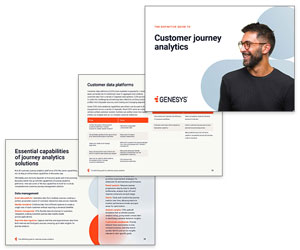Cloud-based contact centres seem to be all the rage. But if you are looking at a cloud-based contact centre what questions should you be asking and how can you avoid the pitfalls?
Bespoke capability
When looking for a cloud-based contact solution, organisations should ensure that the vendor will understand both their requirements and existing processes, give them bespoke capability and the freedom to modify and adapt applications as the contact centre’s campaigns evolve and change.
The second batch of questions to ask should centre on security, performance and resilience; these factors are largely determined by how the hosting centre is accessed and the procedures employed at the centre itself and this should be discussed prior to vendor selection.
Cloud is commonly perceived to be deployed directly over the public internet and so is associated with latency, performance and security issues.
Voice quality of VoIP
Consumer-type VoIP services such as SKYPE have influenced our perception of VoIP quality and performance.
The issue with deploying VoIP directly over the public internet is that VoIP service packetise voice and send it over the network alongside all the data traffic, which is fine if there is sufficient bandwidth. But, just like a traffic jam on a road, if there is congestion caused by an excess of traffic or a bottleneck due to network issues, then, just like at road works, packets are held up and VoIP quality is affected.
Your VoIP network can be specified to avoid this issue and so quality can be guaranteed; dedicated connections can be provided and VoIP traffic is not impeded as it can be with the public internet. In addition, the gateway onto a data network can be set to always prioritise your voice over data traffic, thereby guaranteeing voice quality if your gateway is shared.
Security
And so on to security. The answer is that security is less to do with whether a deployment is in the cloud or not and more to do with the policies and procedures of the individual cloud provider, the hosting environment and the network design and access. If the network and processes are designed correctly then security can be as good as, if not better than, an existing on-premise deployment.

Susannah Richardson
Typical questions to ask would be:
- Is the hosting infrastructure shared or dedicated; how is it partitioned; are data security authentication/passwords applied?
- Who is hosting the servers; do they have good physical and network security?
- Are other authentication mechanisms like Secure ID used?
- Is constant monitoring provided and are proactive tools employed?
- Does the platform adhere to European standards for data protection?
Susannah Richardson, Director of Marketing, mplsystems (www.mplsystems.co.uk)
What happens if the vendor goes out of business
What support mechanism is in place if in the unthinkable event, the vendor goes out of business!
Sent in by one of our readers
Identify your objectives and make sure they are met
If you were to list the main objectives to be met when looking into a cloud-based contact centre, factors such as data security, system reliability, and availability, as well as customer service, immediately spring to mind.
- Security – Look out for the measures your supplier has put in place to ensure security of data, such as being ISO27001 accredited.
- Reliability – Get examples of the system’s performance ability to retain its required functions under different conditions as well as having a contractual point covering this.
- Availability – It is often taken for granted how important system availability at all times is. For example, a contractual Service Level Agreement (SLA) of >95% system availability is one of the measures which you as a customer should ask for when choosing a supplier.
- Customer service – Don’t be afraid to demand the highest levels of customer service. The same way your customers want to speak to a human when issues come up, you are entitled to the same thing.
Is it right for me?
The combination of a peaky contact centre and traditional on-premise applications like call recording can be difficult to manage as flexibility inevitably goes out the window.
The same way as a Facebook page is not the best option for everyone; a cloud-based contact centre may not always apply to every organisation. One way to establish if this is the right way to go would be to look at the cost and scalability factors.
Maximum traffic peak

Toby Sparrow
Do you plan for the maximum peak traffic at the busiest time of year (and pay for the slack for the rest of the year), or do you just struggle when those peaks hit?
A major benefit of a cloud-based contact centre solution is that you pay for what you use. So when it’s quiet, your costs are lower. When the peaks hit, the system handles it, paying for the peak only whilst it’s there.
Toby Sparrow – OPEX Hosting, General Manager (www.opexhosting.co.uk)
Concealed cloud costs
Companies are looking to save money across the board through improved business efficiencies. There are many ways that this can be done, but one of the most effective is to move processes and systems across to the cloud.
However, businesses need to take care when choosing a provider and a service, as there could be unexpected costs.
Look at the cost of changes
Most of these unwanted surprises occur when the customer needs to change its cloud contract for whatever reason – moving premises, increasing/decreasing the number of users, altering the service. The key here is to look for providers that offer a known fixed price for any bespoke or customisation work.
The other expense that might come into play is telephony costs, which are determined by how the system is designed and how the business connects to the solution. Additional costs would come in with the volume of call traffic, but that is no different to having a system in a company’s building – they still need to pay for those variable costs. The costs are not hidden, but neither are they fixed as they are dependent on the volume of traffic the company makes and receives.
Limit the amount of customisation

Dave Paulding
True cloud-based applications should allow the user to manage and administer any changes to cut out the never-ending developing, integration and customisation costs. One way of doing this is for vendors to limit the amount of customisations and changes to the system to keep costs down and therefore ensure that the cost passed on to the customer is limited.
Individuals involved in the decision to migrate to the cloud need to fully understand the extent of the costs involved, both up front and hidden, this will ensure they get their silver lining and are not drenched in a shower of expenses.
Dave Paulding, Regional Sales Director UK, Middle East & Africa, Interactive Intelligence (www.inin.com)
Is the data segregated?
Ask the supplier if your customer data is segregated and secured away from everyone else’s.
Sent in by MikeTalonNYC (Twitter)
Reassess the way you measure effectiveness
In an ideal world, you just switch technology on and it works; but we all know life’s not that simple. That is why, over the years, contact centre operators have devised ways to measure the effectiveness of their technology – and their technology-vendor relationships – from system availability and response-time measures, to maintenance costs, QoS and equipment life.
In the cloud world, much of this thinking must change. Because when things go wrong, as they inevitably will, there will often be little internal staff can do about the situation – organisations will be very reliant on their cloud partners.
Design the right SLAs

Nick Ray
Design SLAs that address traditional measures (such as availability and call blocking rates) as well as cloud-relevant measures (such as voice quality and provisioning, i.e. the time taken to change groups, add sites, make moves and changes, etc.).
SLAs must be realistic and achievable to incentivise cloud vendors but also carry penalties if they fail to perform.
Nick Ray, Director, Infinity CCS (www.infinityccs.com)
Find out the latest in cloud contact centres by reading our article: What to Look for When Buying a Cloud Communications System
Author: Jo Robinson
Published On: 2nd May 2012 - Last modified: 21st Oct 2024
Read more about - Archived Content, Business Systems, Cloud, Genesys, IFS, Infinity CCS, Opex Hosting, Service Level, Susannah Richardson





























